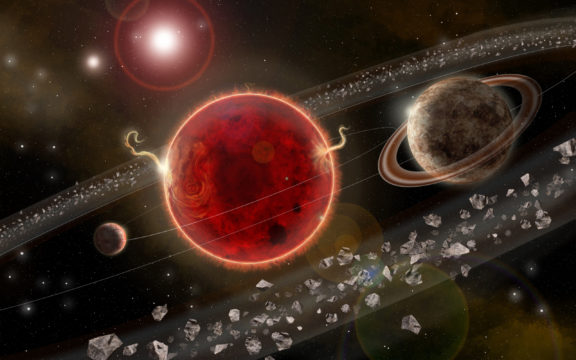Astronomers Discover Second Planet in Nearest Star System – Sky & Telescope
Astronomers have announced the discovery of Proxima Centauri c, an inhospitable super-Earth just 4.3 light-years away.

An artist’s rendering of the Proxima Centauri system shows the newly discovered exoplanet Proxima c (on the right), which orbits its host star in about 5.2 years. The smaller Proxima b, shown on the left, was discovered in 2016. Proxima Centauri is just 4.3 light-years from Earth.
Lorenzo Santinelli
Less than four years after the discovery of a planet orbiting our closest neighboring star, Proxima Centauri, scientists think they’ve discovered a second world in the same system.
The planet, a super-Earth called Proxima Centauri c (Proxima c for short), has at least six times more mass than Earth and orbits its star every 5.2 years. The discovery appears January 15th in the open-access journal Science Advances.
The first planet to be discovered in this system, Proxima b, initially raised astronomers’ hopes: The Earth-size planet orbits Proxima Centauri every 11.2 days, putting it in the so-called habitable zone, where liquid water may exist on a rocky surface. However, further study has showed that the magnetically active star likely robbed the planet of its atmosphere long ago.
Super-Earth Proxima Centauri c
To find the new super-Earth, scientists used the HARPS spectrograph at the La Silla Observatory and the UVES spectrograph on the Very Large Telescope, both in Chile. Mario Damasso (Astrophysical Observatory of Torino, Italy) and colleagues analyzed data collected between 2000 and 2017, looking for the signature “wobble” in Proxima’s Centauri’s light spectrum that would indicate the presence of a planet, the same technique that enabled scientists to confirm the Proxima b’s presence in 2016.
“Stars like Proxima Centauri are rather restless and continuously present eruptions and spots on their surface, which make the detection of a planetary-induced oscillation very complicated,” says coauthor Fabio Del Sordo (University of Crete and Foundation for Research and Technology-Hellas in Heraklion, Greece). Because the observations span almost two decades, the scientists have confidently ruled out those sources of noise, but they caution that follow-up observations are needed to confirm that the signal comes from a planet.
Proxima c is about 1.5 astronomical units (a.u.) away from its star — just a little farther out than Earth is from the Sun, but about 30 times farther out than Proxima b. Because of this large distance, even if the planet were rocky, it would be too cold to host life as we know it.
Challenging Super-Earth’s Origin Story
The planet’s existence challenges theories explaining the formation of super-Earths. Scientists think that super-Earths like Proxima c should form near a snowline — the region where gaseous compounds such as water, carbon monoxide, or ammonia solidify into ices. These regions are sweetspots for super-Earth formation, yet this planet orbits much farther out than the snowlines in its system.
It’s also unlikely that the planet would have formed close to its star only to be kicked farther out, because planet searches indicate that there are no massive planets on closer orbits that could have done the kicking.
Future observations with observatories ranging from the space-based Gaia mission to the submillimeter-wavelength ALMA dishes will help confirm the planet’s existence and explain the planet’s formation.





